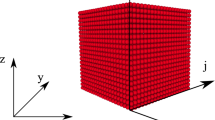Abstract
A three-dimensional discrete element model for elastic solids with large deformations is presented. Therefore, an discontinuum approach is made for solids. The properties of elastic material are transferred analytically into the parameters of a discrete element model. A new and improved octahedron gap-filled face-centred cubic close packing of spheres is split into unit cells, to determine the parameters of the discrete element model. The symmetrical unit cells allow a model with equal shear components in each contact plane and fully isotropic behaviour for Poisson’s ratio above 0. To validate and show the broad field of applications of the new model, the pin–pin Euler elastica is presented and investigated. The thin and sensitive structure tends to undergo large deformations and rotations with a highly geometrically nonlinear behaviour. This behaviour of the elastica can be modelled and is compared to reference solutions. Afterwards, an improved more realistic simulation of the elastica is presented which softens secondary buckling phenomena. The model is capable of simulating solids with small strains but large deformations and a strongly geometrically nonlinear behaviour, taking the shear stiffness of the material into account correctly.

















Similar content being viewed by others
References
Belheine N, Plassiard J-P, Donzé F-V, Darve F, Seridi A (2009) Numerical simulation of drained triaxial test using 3D discrete element modeling. Comput Geotech 36(1):320–331
Braun N (2004) Dichte Packung durch Sechseckschichten: eine Packungsanalyse der Cambridge structural database. PhD thesis
Cleary PW, Sawley ML (2002) DEM modelling of industrial granular flows: 3D case studies and the effect of particle shape on hopper discharge. Appl Math Model 26(2):89–111
Coetzee C, Basson A, Vermeer P (2007) Discrete and continuum modelling of excavator bucket filling. J Terramech 44(2):177–186
Cundall PA, Strack OD (1979) A discrete numerical model for granular assemblies. Geotechnique 29(1):47–65
D’Addetta GA, Kun F, Ramm E, Herrmann HJ (2001) From solids to granulates-discrete element simulations of fracture and fragmentation processes in geomaterials. In: Vermeer PA, Herrmann HJ, Luding S, Ehlers W, Diebels S, Ramm E (eds) Continuous and discontinuous modelling of cohesive-frictional materials. Lecture notes in physics, vol 568. Springer, Berlin. https://doi.org/10.1007/3-540-44424-6_17
Dobry R, Ng TT (1992) Discrete modelling of stress-strain behaviour of granular media at small and large strains. Eng Comput 9(2):129–143
Griffiths D, Mustoe GG (2001) Modelling of elastic continua using a grillage of structural elements based on discrete element concepts. Int J Numer Methods Eng 50(7):1759–1775
Hou Q, Dong K, DEM Yu A (2014) study of the flow of cohesive particles in a screw feeder. Powder Technol 256:529–539
Kaixin L, Lingtian G (2003) The application of discrete element method in solving three-dimensional impact dynamics problems. Acta Mech Solida Sin 16(3):256–261
Kuznetsov V, Levyakov S (2002) Complete solution of the stability problem for elastica of Euler’s column. Int J Non-linear Mech 37(6):1003–1009
Paulick M, Morgeneyer M, Kwade A (2015) Review on the influence of elastic particle properties on DEM simulation results. Powder Technol 283:66–76
Tavarez FA, Plesha ME (2007) Discrete element method for modelling solid and particulate materials. Int J Numer Methods Eng 70(4):379–404
Timoshenko SP, Gere JM (2009) Theory of elastic stability. Courier Corporation
Wang Y, Mora P (2008) Macroscopic elastic properties of regular lattices. J Mech Phys Solids 56(12):3459–3474
Zhao C, Hobbs B, Ord A, Hornby P, Peng S, Liu L (2007) Particle simulation of spontaneous crack generation problems in large-scale quasi-static systems. Int J Numer Methods Eng 69(11):2302–2329
Acknowledgements
The support of the German Research Foundation (DFG) in the frame of the Graduiertenkolleg 2075 ’Modelling the constitutive evolution of building materials and structures with respect to ageing’ is gratefully acknowledged.
Author information
Authors and Affiliations
Corresponding author
Appendix
Appendix
Crystals consisting of a face-centred cubic packing have three independent elastic components in the tensor \(\mathbb {C}\). \(\hat{\mathrm {C}}_3\) can be expressed as
if there is fully isotropic behaviour. For the simple face-centred cubic packing (Index fcc) without filled gaps, the tensor of elasticity resulting from the Eq. (19) is
where
Evaluating equation (28) yields a condition that
which can only be achieved for \(\nu =0\). This states, that the simple face-centred cubic packing has cubic anisotropy for Poisson’s ratio above zero and therefore has three independent elastic constants. Due to the filling of the octahedron gaps, a third parameter is included. Evaluating equation (28) again for the tensor of elasticity from Eq. (20) yields in a new condition for isotropy
Equation (32) can be fulfilled for every \(\nu \). Therefore, the three components can be reduced to two independent elastic constants.
Rights and permissions
About this article
Cite this article
Ockelmann, F., Dinkler, D. A discrete element model for the investigation of the geometrically nonlinear behaviour of solids. Comp. Part. Mech. 5, 335–344 (2018). https://doi.org/10.1007/s40571-017-0172-5
Received:
Revised:
Accepted:
Published:
Issue Date:
DOI: https://doi.org/10.1007/s40571-017-0172-5




